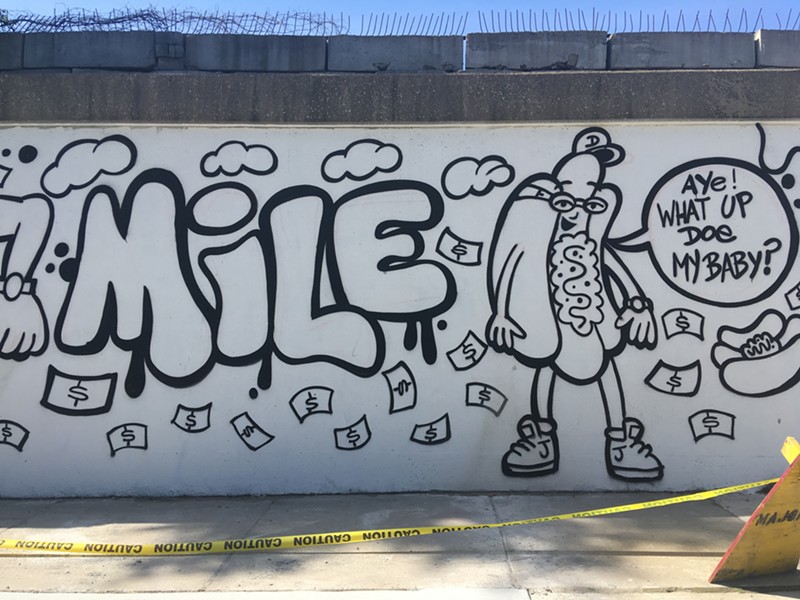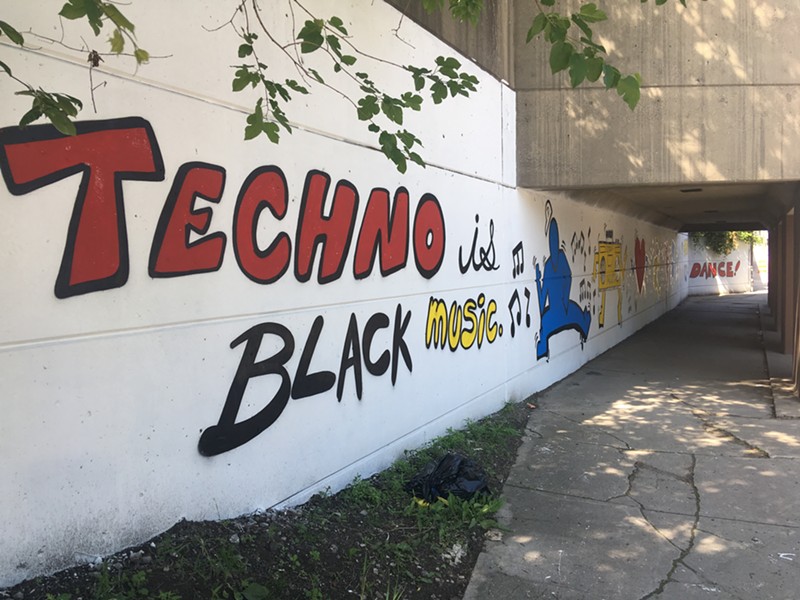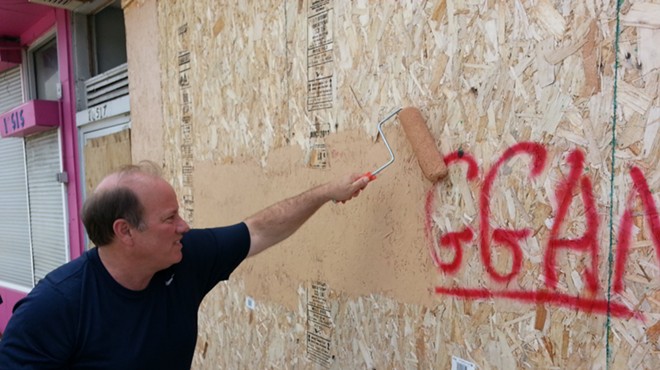A popular street artist was arrested by Detroit police last week after he was initially believed to be vandalizing city property. He was actually painting a mural that he had a permit from the city to create.
Sheefy McFly, whose real name is Tashif Turner, was working on a mural under a viaduct east of Seven Mile Road and John R as part of the City Walls program. Launched in 2017, the program pays artists a stipend and provides materials for them to create public art in vandalism-prone areas in an effort to help deter graffiti.
Turner says City Walls issued him a permit that he was required to have on him while working on the mural. They sent him a PDF of the document, which he says he had to print out himself at FedEx. On his first day of work, he says, police questioned him but left him alone after he showed them the permit. After a few days of working on the mural, he felt like the local police had become comfortable with his presence, and on Wednesday, he forgot to bring his permit.
Later that afternoon, two new police officers approached him, believing him to be vandalizing the viaduct.
"I told them I'm painting this mural for City Walls, and I got to have it done by Friday," Turner, 29, says. "They asked me to put my hands down and everything. I'm like, what's going on?"
Turner says when one of the officers tried to handcuff him, he attempted to pull away and walk toward his bag to find his permit. That's when things got physical.
"When I tried to walk towards my bag, they tried to act like I was resisting arrest and trying to run," he says.
"They ran up on me like I'm dealing dope, bro, like I had crack on me and I had a gun in my bag," he says.
Eventually the officers called for backup and put Turner in the back of a car. Turner says he told the officers to contact Zachary Meers, the City Walls coordinator whose name and phone number is listed on the permit. Eventually, Turner says he stopped resisting the officers.
"I just kept my composure because I felt like if I actually got angry, they can shoot," he says. "Like they will shoot me or they will beat me and I'm gonna still go to jail."
The officers did reach Meers, who assured them Turner had a permit. But it was too late. The officers found Turner had a warrant out for his arrest, stemming from a traffic violation from years ago.
Turner spent the next 24 hours DPD's detention center. He said he was placed in a cell with more than a dozen men and no beds. One man, he alleges, was bleeding. He was released on Thursday.
Detroit PD spokeswoman Holly Lance maintains that the department did nothing wrong, and says that Turner was detained because of the existing warrant for his arrest, resisting, and obstruction. She says vandalizing a viaduct is a felony that could cost more than $10,000 to clean up, and that officers had to investigate.
"The bottom line is he had a permit, but he wasn't able to produce it. His actions resulted in what occurred next," Lance says. "He was being investigated for a felony. He did not cooperate with officers or have proper documentation."
But Lance admits that officers can choose not to detain someone who has a warrant out for their arrest.
"If you have contact with police and you have a warrant, it's at the discretion of the officer to arrest you," she says. "They can either advise you that you have a warrant for your arrest, or they can take you in for it."‘They just obviously saw me as a graffiti writer and treated me like a criminal,’ Turner says.
tweet this
Turner believes race played a role in how he was treated.
"When I speak with a stern voice, people get scared 'cause I got a deep voice," he says. "I got a manly voice. You know, I'm 6 foot, I'm 200 pounds, I'm Black as hell."
"They just obviously saw me as a graffiti writer and treated me like a criminal," he says.
"That's what makes me so angry about it because all my life, I never painted illegally at all. I don't do nothing bad," says Turner, who has created murals in the city alongside internationally recognized street artists as part of the Murals in the Market festival. "So for them to come out and treat me like a criminal, like I shot somebody ... it just had me feeling like I was profiled, you know."
Brad Dick, a City of Detroit executive who works with City Walls, says the program does alert local precincts about its mural projects, but in this case the officers who arrested Turner had not been notified.
When asked why the officers who arrested Turner had not been briefed on the City Walls project, Lance responds with a question of her own.
"In a city as large as ours, with 12 precincts, you're asking if every officer in the city — our department has over 3,000 members — if they're briefed if one individual is given a permit to spray paint a viaduct in one part of the city?" she asks.
Dick says he's ordering changes to the program to make sure this doesn't happen again, like setting up sandwich board signs at City Walls work sites that say it's a city-sponsored project, and also requiring artists to wear a lanyard so that the permit is on them at all times.
"We love this program," he says. "We want it to continue. It's a great program that the residents love, everybody loves it. But we need to make sure that the artists are covered ... that show that they're there with our approval."
As Detroit's reputation as an arts and culture hub has grown — especially one with a strong DIY ethic — city officials have at times struggled with how to grapple with it. Once he took office, Mayor Mike Duggan launched an aggressive crackdown on graffiti to attempt to deter blight and crime, which has resulted in dozens of arrests and thousands of graffiti tickets. But critics charge the broken windows theory-inspired crackdown is overzealous, with officials punishing building owners for murals they sanctioned, believing them to be graffiti.
Last month, the city hired former Detroit Free Press journalist Rochelle Riley to serve as its first director of arts and culture "to advocate for, promote, and develop arts and culture." She declined to comment.
Turner believes the city has a long way to go when it comes to educating DPD and other city officials about art. He thinks it should have been immediately obvious to officers that his City Walls project was a sanctioned mural and not graffiti.
By the time he was arrested, he had been working on the mural for days, and the sprawling, colorful design took up nearly an entire block. The mural is illustrative, with parts depicting a cartoon coney dog saying "What up doe my baby?" and another with Keith Haring-inspired dancing figures and lettering saying "Techno is Black music." It's an intricate mural created in broad daylight, not a quick territory-marking graffiti throw-up or tag done under the cover of darkness.
"They got like this graffiti task force or whatever, but they ain't know about the City Walls thing," Turner says. "So that got me thinking, like, how can artist mural shit be going on in the city and the city don't even know about it? It just seems crazy to me."





